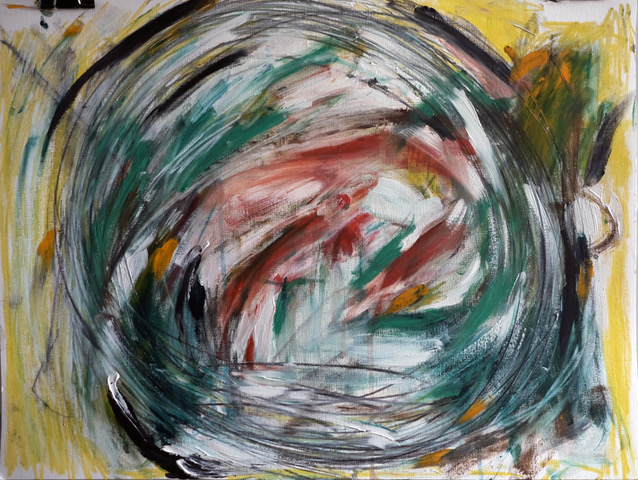During the pandemic lockdown, my garden became a refuge from the dangerous virus circulating through the air but also a kind of prison, beyond which I did not want to venture. This image expresses the anxiety of confinement but also of safety in the center of the vortex.
During lockdown, I thought about making art about my garden, but being paralyzed by anxiety and despair, and also wary of making art about the pandemic, I stopped myself from creating. I did not want to touch those emotions. Now, as I recover, art has returned to me. I often put my paintings and drawings on an easel where I can consider them. Though I painted this image as an emotional expression, I later saw how it contained the colors of my garden space, a swirled version of that other image I never made.
But does it relate to the Noli Me Tangere? The last time I considered this text was in religion class at Mercy High School in Middletown, Connecticut. One semester, we read the Matthew, Mark, Luke, and John in a cheap paperback text called The Good News. The book fell apart as I read it. I recall Father Richard entertaining my skeptical comments about the text, even while my classmates kept telling me that I needed to take these, to my mind, confusing and sometimes contradictory accounts of Jesus' life, as a matter of "faith." While reading, questioning, and interpreting texts has remained with me, I consider the less conscious art practices I engage in to be a means of accessing this type of "faith" my classmates urged me towards.
In high school, I felt the lead was buried somewhat in the text. Why is it not more of a surprise that a dead person's body is suddenly gone? Why would anyone assume that a living person would be that formerly dead one? However, the pandemic highlights the act of separation in the Noli Me Tangere, making it more approachable. Lockdown gave wild animals a chance to enter what was human dominated space. Lines of separation, between what is considered wild and domesticated were blurred. Humans create divisions, distinctions, and definitions. My garden is my space where I cultivate domesticated plants, allowing them to establish corners where they can flourish. It seems in the Noli Me Tangere, Jesus makes it clear that there is a space of separation between himself and the living, that he has crossed a line in existence and that these lines cannot be blurred. Is that why he appears as a gardener, who designates order? I am not sure. My painting shows the center of a garden surrounded by a barrier beyond which there is bright light. Inside the barrier, is a calmer space of floating whites, greens, and reds. It is inside this space where I remain contained, untouched, and protected.
